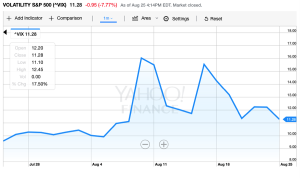
The last few weeks have been quite turbulent for volatility traders with swings in the VIX of greater than 20% on several occasions. The roller-coaster ride in volatility indicated in the chart below identifies, however, real opportunity and not just implied opportunity. Timing volatility from the long side would prove to be difficult, but adding short positions into volatility spikes has proven more advantageous and with great capital gains.

Having reduced my short exposure to volatility ahead of those rip-roaring spikes in the VIX, I was fortunate enough to recapture my short positions significantly higher than where I had covered. And it’s with great appreciation for the VIX and volatility that I am found to have benefited from the most recent decline in the VIX by way of shorting VIX-leveraged ETPs such as ProShares Ultra VIX Short-Term Futures ETF (UVXY), VelocityShares Daily 2x VIX Short-Term ETN (TVIX) and iPath S&P 500 VIX Short-Term Futures ETN (VXX). Over the last 5 years plus I have been shorting these products on most any spike in the VIX that expresses a spike in these ETPs. For those who don’t have the stomach to short double leveraged products the inverse ETPs like VelocityShares Daily Inverse VIX Short-Term ETN (XIV) and ProShares Short VIX Short-Term Futures ETF (SVXY) might be a good fit for shorting volatility, as they are “long products.”
I’ll admit, the stochastics for the major averages are not looking favorable at the moment and largely adding to the movement in the VIX. The S&P 500 has pulled back roughly 3% from its all-time high. Fits and starts have plagued the index from recapturing its momentum due to rising fears surrounding the North Korean threat and general lacking of volume in the markets during the August- September period. August 23rd proved to be the lowest trading volume of the year for the equity markets. Total composite volume for U.S. stocks finished at 5 billion shares on August 23rd according to Dow Jones data. The average daily volume for August is 5.98 billion shares and for the year it’s 6.54 billion shares. Where there is light trading volume there tends to be a greater propensity for markets to express volatility.
I’ve encouraged many of my followers, friends and associates partaking in a VIX-leveraged ETP strategy to employ great liquidity during the August-September period. For those of you who recall the August 2015 massive VIX spike that found shares of UVXY having appreciated upwards of 200+ percent you certainly understand as to why I expressed this measure of risk management. With a baseline of 200% liquidity in a trader/investor brokerage account your margin of error for shorting VIX-ETPs is well established. The following graphic (care of Guillermo Gomez) identifies my 20% core VIX-ETP short strategy in use for an independent trader’s brokerage account of $100,000 and a margin requirement of 100 percent.

In the event that an August 2015-like event came to pass the market values indicated would find the trader’s brokerage account at its limit before achieving a maintenance call. To be perfectly clear, the graphic doesn’t assume any additional trading positions or a uniform, 1-day VIX/ETP move of 200 percent. The graphic only assumes/depicts a core VIX-ETP short position value. For the most part, if traders/investors utilize a 20% core short VIX-ETP holding strategy annually, they do quite well. “But that’s only 20% Seth? Doesn’t it seem like a waste to only use that strategy or that little capital?” That’s a reasonable question.
Maintaining a 20% core UVXY or TVIX position annually and doing little else with one’s trading/investing capital may seem limiting, but the reality is quite the opposite. The decay on the two VIX-leveraged ETPs annually has been greater than 90 percent. For arguments sake and simplifying the numerical values let’s just say a trader/investor can double their capital invested annually by shorting these products. So if we take the model above on a $100k account with a 20% ($20K) short investment the trader/investor would have generated a 40% ($40K) return on their brokerage capital account for the year. Such a performance would have outperformed the benchmark S&P 500 rate of return for the year. That’s where you want to be as a trader/investor, beating the benchmark. And for those who follow my activity on Twitter and StockTwits, they come to understand that maintaining a 20% core position while scalping profits from intraday trading adds another layer of double-digit capital returns. Lastly, come the 4th quarter of 2017 and what has traditionally been a period of complacency with the S&P rallying through the holiday season, who’s to say a 20% core strategy can’t expand by 10% with measured risk? Mo money, mo money, mo money.
















